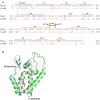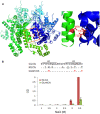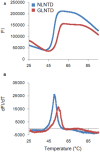Comparison of Biochemical Properties of HIV-1 and HIV-2 Capsid Proteins
- PMID: 28659897
- PMCID: PMC5469281
- DOI: 10.3389/fmicb.2017.01082
Comparison of Biochemical Properties of HIV-1 and HIV-2 Capsid Proteins
Abstract
Timely disassembly of viral core composed of self-assembled capsid (CA) in infected host cells is crucial for retroviral replication. Extensive in vitro studies to date on the self-assembly/disassembly mechanism of human immunodeficiency virus type 1 (HIV-1) CA have revealed its core structure and amino acid residues essential for CA-CA intermolecular interaction. However, little is known about in vitro properties of HIV-2 CA. In this study, we comparatively analyzed the polymerization properties of bacterially expressed HIV-1 and HIV-2 CA proteins. Interestingly, a much higher concentration of NaCl was required for HIV-2 CA to self-assemble than that for HIV-1 CA, but once the polymerization started, the reaction proceeded more rapidly than that observed for HIV-1 CA. Analysis of a chimeric protein revealed that N-terminal domain (NTD) is responsible for this unique property of HIV-2 CA. To further study the molecular basis for different in vitro properties of HIV-1 and HIV-2 CA proteins, we determined thermal stabilities of HIV-1 and HIV-2 CA NTD proteins at several NaCl concentrations by fluorescent-based thermal shift assays. Experimental data obtained showed that HIV-2 CA NTD was structurally more stable than HIV-1 CA NTD. Taken together, our results imply that distinct in vitro polymerization abilities of the two CA proteins are related to their structural instability/stability, which is one of the decisive factors for viral replication potential. In addition, our assay system described here may be potentially useful for searching for anti-CA antivirals against HIV-1 and HIV-2.
Keywords: CA-polymerization; CA-stability; Gag-CA; HIV-1; HIV-2; NTD.
Figures







Similar articles
-
Novel In Vitro Screening System Based on Differential Scanning Fluorimetry to Search for Small Molecules against the Disassembly or Assembly of HIV-1 Capsid Protein.Front Microbiol. 2017 Jul 24;8:1413. doi: 10.3389/fmicb.2017.01413. eCollection 2017. Front Microbiol. 2017. PMID: 28791001 Free PMC article.
-
Critical Role of the Human T-Cell Leukemia Virus Type 1 Capsid N-Terminal Domain for Gag-Gag Interactions and Virus Particle Assembly.J Virol. 2018 Jun 29;92(14):e00333-18. doi: 10.1128/JVI.00333-18. Print 2018 Jul 15. J Virol. 2018. PMID: 29695435 Free PMC article.
-
Disparate Contributions of Human Retrovirus Capsid Subdomains to Gag-Gag Oligomerization, Virus Morphology, and Particle Biogenesis.J Virol. 2017 Jun 26;91(14):e00298-17. doi: 10.1128/JVI.00298-17. Print 2017 Jul 15. J Virol. 2017. PMID: 28446667 Free PMC article.
-
The capsid protein of human immunodeficiency virus: intersubunit interactions during virus assembly.FEBS J. 2009 Nov;276(21):6098-109. doi: 10.1111/j.1742-4658.2009.07313.x. FEBS J. 2009. PMID: 19825044 Review.
-
The HIV-1 capsid protein as a drug target: recent advances and future prospects.Curr Protein Pept Sci. 2013 Dec;14(8):658-68. doi: 10.2174/13892037113146660084. Curr Protein Pept Sci. 2013. PMID: 24106962 Review.
Cited by
-
An NAD+-dependent novel transcription factor controls stage conversion in Entamoeba.Elife. 2018 Oct 30;7:e37912. doi: 10.7554/eLife.37912. Elife. 2018. PMID: 30375973 Free PMC article.
-
Human Immunodeficiency Virus Type 2 Capsid Protein Mutagenesis Reveals Amino Acid Residues Important for Virus Particle Assembly.J Mol Biol. 2022 Oct 15;434(19):167753. doi: 10.1016/j.jmb.2022.167753. Epub 2022 Jul 19. J Mol Biol. 2022. PMID: 35868362 Free PMC article.
-
Structural insights into HIV-2 CA lattice formation and FG-pocket binding revealed by single-particle cryo-EM.Cell Rep. 2025 Feb 25;44(2):115245. doi: 10.1016/j.celrep.2025.115245. Epub 2025 Jan 25. Cell Rep. 2025. PMID: 39864060 Free PMC article.
-
Novel In Vitro Screening System Based on Differential Scanning Fluorimetry to Search for Small Molecules against the Disassembly or Assembly of HIV-1 Capsid Protein.Front Microbiol. 2017 Jul 24;8:1413. doi: 10.3389/fmicb.2017.01413. eCollection 2017. Front Microbiol. 2017. PMID: 28791001 Free PMC article.
-
Design, Synthesis and Structure-Activity Relationships of Phenylalanine-Containing Peptidomimetics as Novel HIV-1 Capsid Binders Based on Ugi Four-Component Reaction.Molecules. 2022 Sep 14;27(18):5995. doi: 10.3390/molecules27185995. Molecules. 2022. PMID: 36144727 Free PMC article.
References
LinkOut - more resources
Full Text Sources
Other Literature Sources

